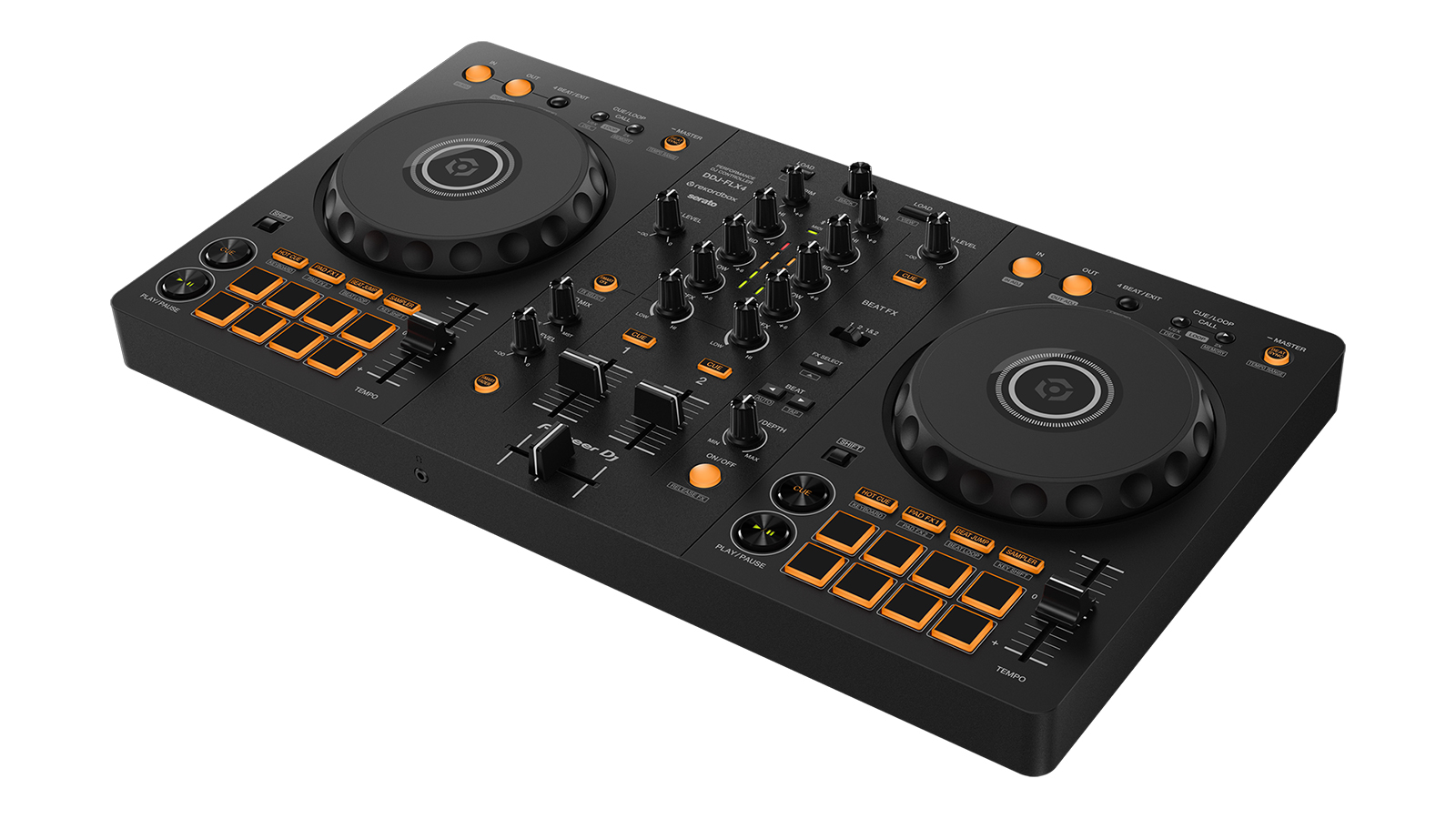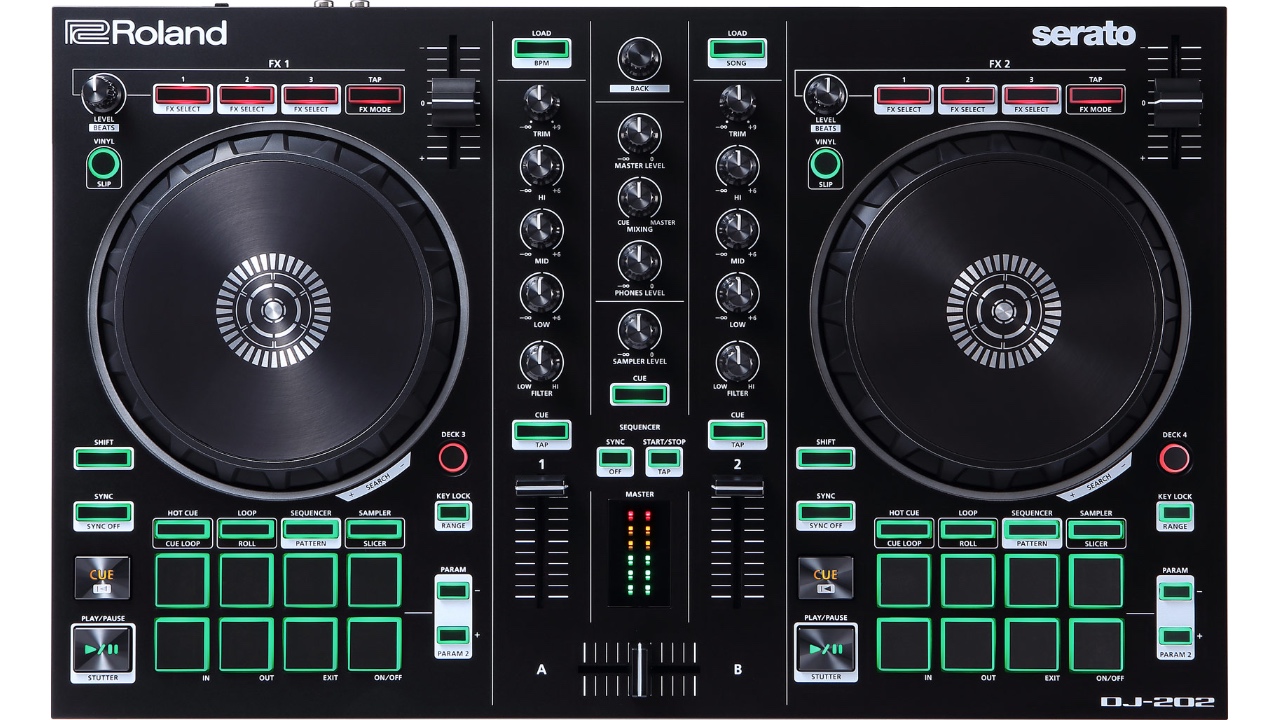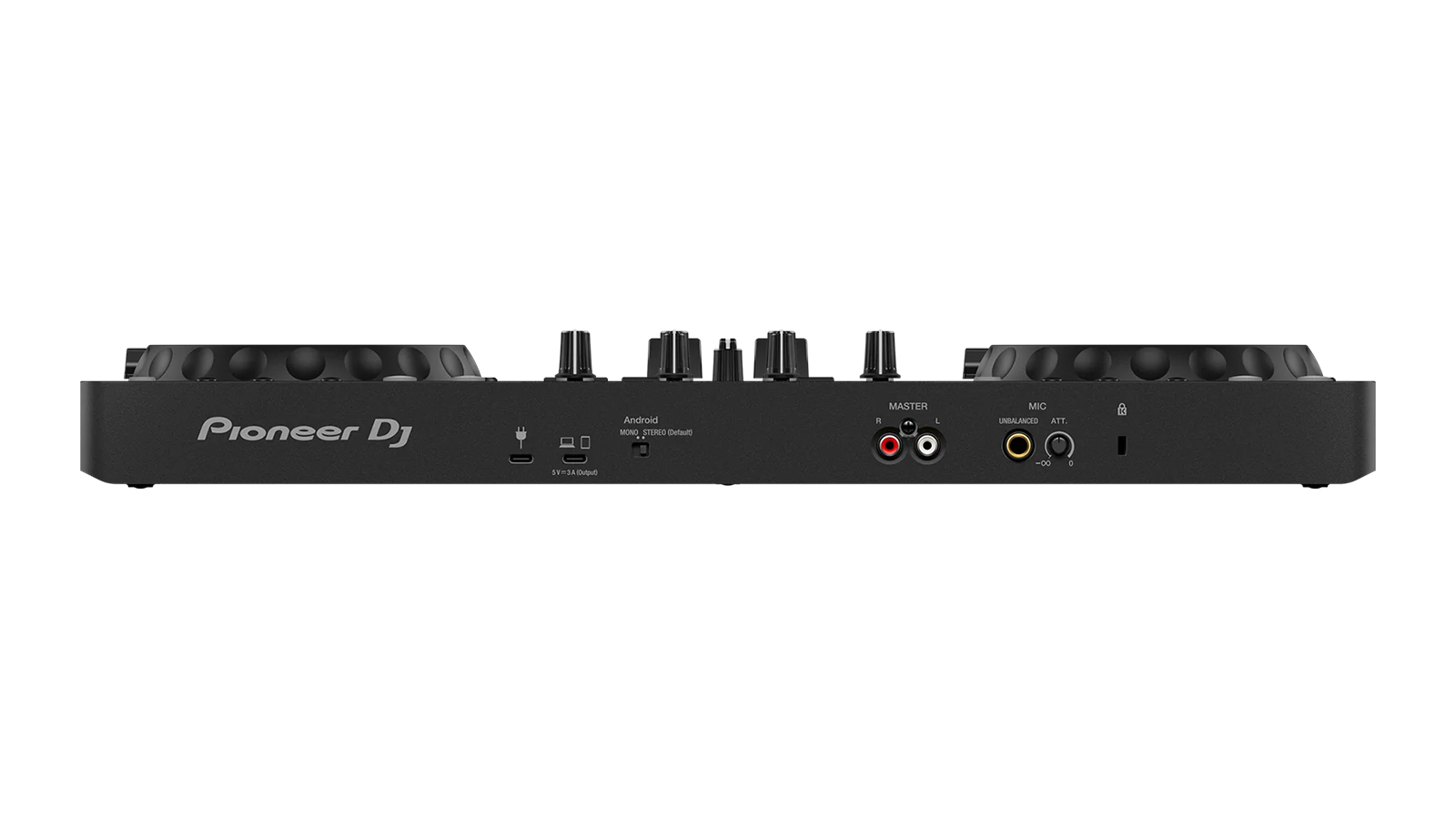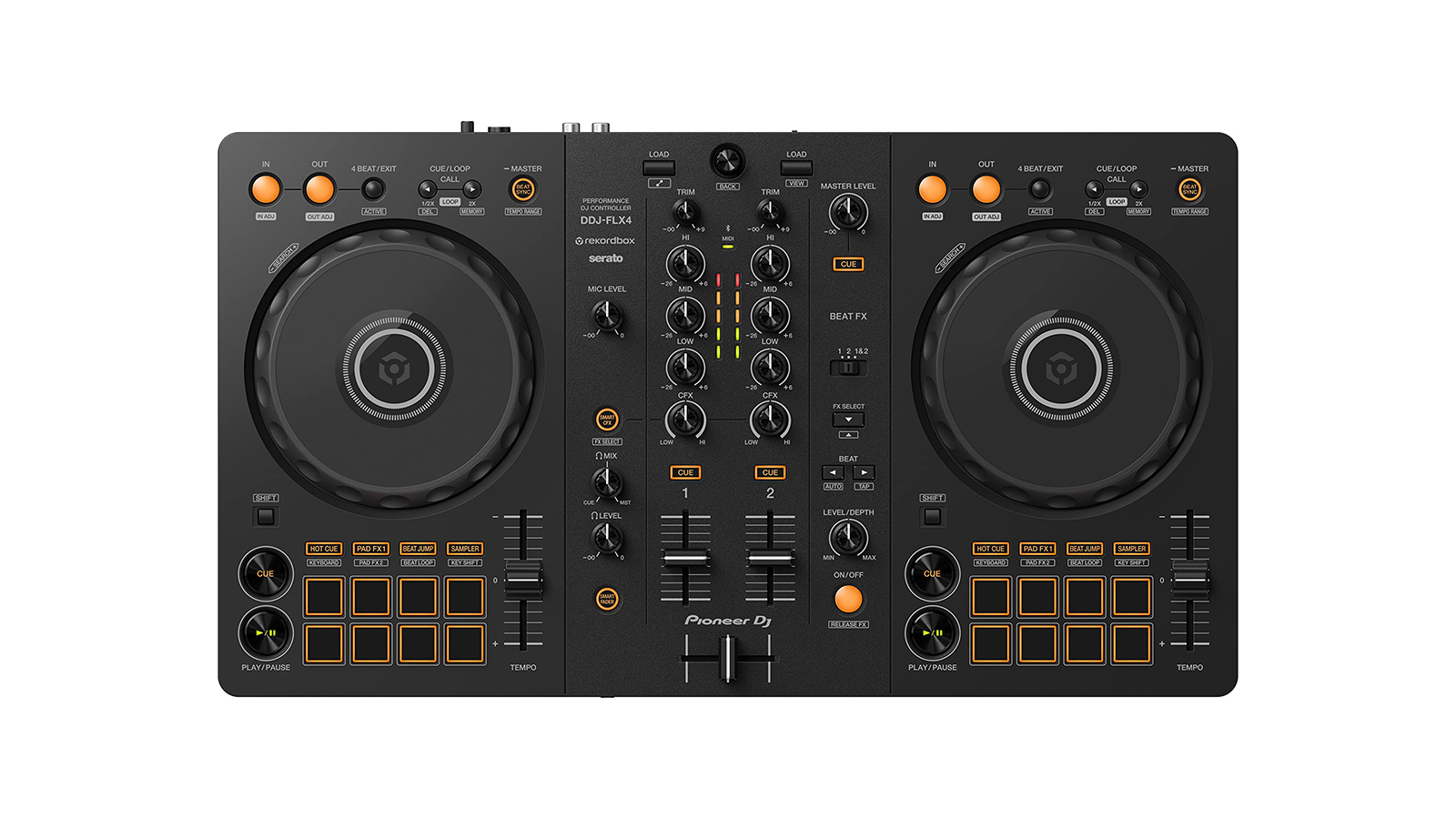MusicRadar Verdict
With its smart mixing function, Bluetooth compatibility, mic signal integration and general ease of use, simple design and overall functionality, the FLX4 is likely to be a successful successor to the DDJ-400, and is a strong contender for best beginner’s DJ controller on the market right now.
Pros
- +
Loads of functionality but also very accessible
- +
USB carries mic output
- +
Bluetooth connectivity
- +
Automatic mix and FX functions are surprisingly effective
Cons
- -
Single-colour visual design isn’t as clear as it could be
- -
No jog wheel display
- -
Auto Mix and FX functions would benefit from a bigger crossfade
MusicRadar's got your back
Pioneer DDJ-FLX4 review: What is it?
The Pioneer DDJ-FLX4 is a two-channel USB-C/Bluetooth enabled digital DJ Controller that works straight out of the box with either free rekordbox software or Serato or djay. It’s based on the classic Pioneer CDJ design with a pair of jog wheels, a set of performance pads for each deck, and a mixer section in the middle, but in a stripped-down, compact and accessible format, clearly targeted as a beginner DJ controller. It’s not a professional unit so it’s small with small controls, it only has two channels and no balanced outputs, but it has all the functionality required for a DJ just starting out. My review was conducted on a Mac with rekordbox but you can now use the FLX4 via the rekordbox mobile iOS/Android app, too.
The FLX4 replaces Pioneer’s very popular DDJ-400 controller, and they’ve taken the opportunity to make a few updates, in look, functionality and specification. There's a visual redesign and new colour scheme, new automatic smart FX and smart mixing functions, Bluetooth connectivity meaning you DJ off your phone, Serato compatibility, and the ability to include the mic output in the main output, meaning you can easily sing, MC or chat over your mixes.
Pioneer DDJ-FLX4 review: Performance & verdict

Setting up presents no problems at all, it’s literally plug (the USB C connection into your computer) and play. Assessing the controls, I found the jog wheels to be small and light but with a solid enough feel to them in the mix, although they don’t have any visual display unlike rival Numark Platinum FX, which is a shame. The volume faders, EQ, and filter knobs were a good size, while the pads and jog wheels felt a little small, but at this price point, size compromises are inevitable. Both the pads and the play and cue buttons responded fine during my testing, and generally the knobs and faders felt light, but rugged enough for home use. The overall build quality feels reasonably good for the price point and is comparable to other similarly priced units.

- Native instruments Tractor Control S2 Mk3 (read our review)
- Numark Mixtrack Platinum FX
- Roland DJ-202 DJ
The layout of the controls remains largely the same as on the DDJ-400, and the simple, uncomplicated design suggests much thought went into making the unit look and feel accessible. This is largely successful but, and it’s a small gripe, the DDJ-FLX4 has been almost too visually simplified. The filter knobs on the 400 and the FLX4 are in the same place, but are way more clearly defined on the 400, which also has white vertical lines on the front panel separating the various sections of the mixer. Mid-mix on the FLX4 I often found myself reaching for the filter thinking it was the bass EQ, and prefer the 400’s more clearly demarcated mixer controls.
In terms of sound, the EQ and filters all sound absolutely fine, the headphone volume and quality of signal were perfectly acceptable, and the crossfader, trim controls and track faders all do exactly what you would expect them to. The FLX4 comes with individual volume LED indicators but unfortunately, no overall LED display for the main output, though this is pretty standard at this price point too. In terms of ins and outs, things are pretty simple around the back with a 6.3 mm unbalanced mic input, two USB-C inputs, and a stereo unbalanced master output, and there’s a single minijack headphone socket on the front of the unit.

The big innovation here is the new ‘smart fader’ and ‘smart CFX’ functions, both of which define the unit as clearly targeted at beginners. You hit the smart mix button and as you move the crossfader from left to right, it automatically adjusts the tempo to the incoming song, even if you’re mixing 80bpm hip-hop into 150bpm techno. It also automatically adjusts the bass and volume for you too, and even adds a little echo at the end of the mix as a flourish. And the smart CFX function is equally simple: you hit the smart FX button and the filter knobs become multi-effects level knobs. While the automatic mixing function may be anathema to many older DJs, there’s no doubt it works pretty well, and would be a super fun function for a newbie DJ. My only critique of how it operates is that because the crossfader is so small, it’s easy to ‘rush’ the mix; a couple of extra centimeters on the crossfader would have been nice.
Other improvements from DDJ-400 are that the FLX4 can be used with your phone as it now comes with Bluetooth connectivity, and is also compatible with Serato. Pioneer has also routed the mic output via USB to your computer, meaning that if you want to MC, sing or chat along with your DJ livestream, you can do it without needing an extra mixer. Overall, a greta bit of kit for the money, which would be the perfect starting point for any beginner DJ.
Pioneer DDJ-FLX4 review: Hands-on demos
Crossfader
Digital DJ Tips
Cleveland Terry
Pioneer DDJ-FLX4 review: Specification
- Compatibility: rekordbox (Mac/Windows/iOS/Android), Serato DJ Lite, Serato DJ Pro, djay (iOS/Android)
- Soundcard: 16bit/24bit, 44.1 kHz/48 kHz
- Channels: 2
- Deck control: 2
- Inputs: 1x mic
- Outputs: 1x master (RCA), 1x phones (3.5-mm stereo mini jack)
- Contact: Pioneer DJ
Harold Heath is a UK music writer and author. A DJ since the late 80s, Harold also produced a few hundred singles and remixes and two artist albums, and worked as a performer, ghostwriter and music-technology teacher. His first book Long Relationships: My Incredible Journey From Unknown DJ to Smalltime DJ was published in 2021.
“Excels at unique modulated timbres, atonal drones and microtonal sequences that reinvent themselves each time you dare to touch the synth”: Soma Laboratories Lyra-4 review
“I used everything I knew about music”: How Green Day exceeded expectations with their most ambitious song
YouTube just added AI tools that makes musicians, library music and video editors redundant














